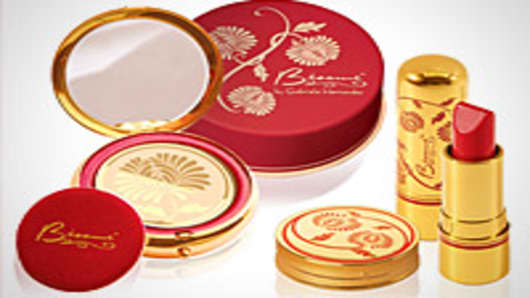“The formulas of lipsticks from those early eras were very different,” said Hernandez, who also wrote a book, “Classic Beauty: The History of Makeup,” about how cosmetics have changed throughout the years.
“The stains were very waxy and the product was meant to be put on and blotted off almost completely, and then reapplied. Ideally you looked as though you had no makeup on, only color. Cream rouge also had a special way of being applied.”
Eventually she found a cosmetics laboratory willing to work with her to analyze formulas to make sure the colors didn’t bleed, which is often a problem with shades of red.
Bésame’s products are sold in apothecaries, specialty and vintage stores and online; her line includes 12 shades of lipstick, face powder, powder rouge, eye liner, lip pencils, mascara and the new crimson rouge, which is a cream rouge that comes in one color and retails in the U.S for about $22.
The cream rouge has been a big hit abroad. “Customers have gone crazy for it here,” said Katie Thomas, who distributes Bésame Cosmetics in the U.K. and western Europe. She is also the founder and CEO of What Katie Did , a London-based faux-vintage company that manufactures lingerie inspired by the styles of the 1940s and 1950s.
“A lot of people initially bought crimson rouge because of the packaging, and then were pleasantly surprised with the quality,” she said. “It comes in a big tin, so it’s good value, and because it comes in just one color it’s easy to buy.”
This is one industry where customers are judging a product by how it’s packaged.
“We’re seeing more cosmetic companies creating products based not only on vintage packaging but also on the variety of bright reds that were popular in the ’30s, ’40s and ’50s,” said Ian Ginsberg, owner and president of C. O. Bigelow Apothecaries in New York, and chairman of the board of Independent Cosmetic Manufacturers and Distributors.
Alexandra Smith, consumer trends analyst for market research company Mintel International, sees the popularity of vintage tied to fashion-minded men and women wanting a more polished look. “They’re paying more attention to the details and being more restrained, doing without a lot of bling. But if they do splurge on a mini-indulgence, like lipstick, they will gravitate to the prettiest packaging.”
And that means, at least for Bésame, that their products can steal the scene, both on-screen and off.
email: patricia.orsini@nbcuni.com


